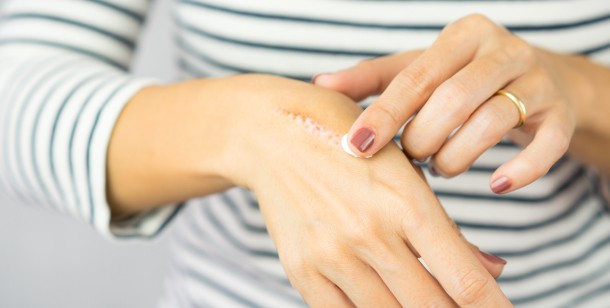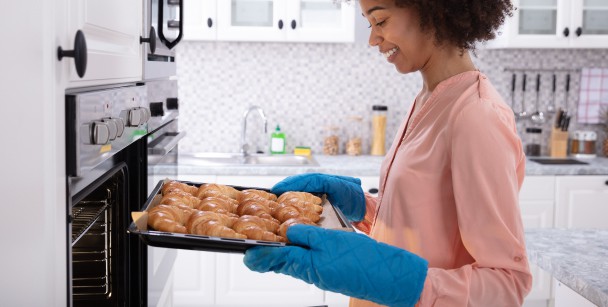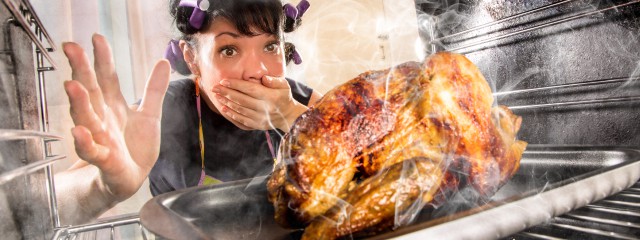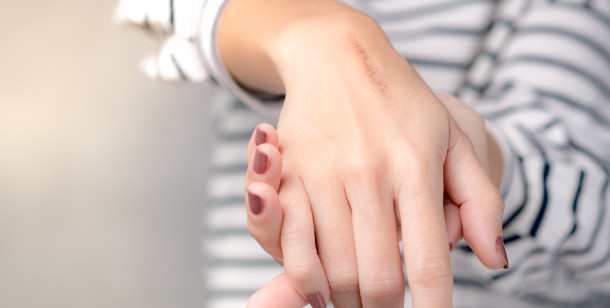During the holidays, people tend to find themselves in the kitchen more often than the rest of the year combined. And because holiday cooking is usually accompanied by stress and rushing, you’re less likely to take the standard kitchen safety precautions necessary to prevent injuries. Oven and stovetop cooking burns are common, with victims ranging from novices to expert chefs. And while most burns are trivial enough for at-home care, some may pose a serious health issue. Keep reading to learn how to treat an oven burn, how to protect your skin, and when to see a doctor.

Types of Burns
The first step to treating a burn is figuring out the severity. Most kitchen burns aren’t very serious, but being able to self-diagnose whether you have a first, second, or third-degree burn helps determine the best course of action.
First-Degree Burns
- First degree burns are isolated to the top layer of the epidermis and are typically accompanied by pain, swelling, or redness. You can get a first-degree burn by accidentally (and briefly) touching a hot pan or curling iron. This is the most common type of cooking-related burn and, because these types of burns are superficial, you usually will not need to seek professional treatment.
Second-Degree Burns
- Second-degree burns are also accompanied by pain, redness, and swelling, but tend to have other symptoms that cause increased discomfort and a higher chance of infection. You might experience thickening of the skin, blistering, and persistent tenderness in the area. This type of burn extends to the lower layers of the skin, and is usually caused by pressing down on something hot or spilling boiling liquid on yourself.
Third & Fourth-Degree Burns
- Third & fourth-degree burns are the most serious type of burns. They destroy the skin completely along with the lower levels of tissue. Skin affiliated with these kinds of burns tend to look charred or white, and victims are likely to experience numbness and loss of sensitivity.

How to Avoid Oven Burns
When you’re preparing a meal, it’s easy to get swept up in the actual preparation and forget to observe basic safety practices. In order to avoid getting burned skin in the kitchen, you should:
Start with a clean cooking space
- Keeping a tidy kitchen is key to avoiding injuries! Not only does it help you move about your kitchen easier, but it makes tripping on or knocking something over far less likely. Cleaning up as you go can help keep your kitchen as accident-free as possible!
Keep oven mitts out and easily accessible
- One of the most common ways to burn yourself in the kitchen is to try and remove something from the oven and forgetting to put on your oven mitts. It’s an easy, absent-minded mistake to make. After all, you can hardly be expected to think clearly while inhaling the smell of your delicious food! But by keeping your oven mitts visible and near the oven, you’re less likely to reach in without them.
Turn handles to the wall
- By turning your handles towards the wall, you’re far less likely to walk past a hot pot or skillet and knock it over by bumping it. Children and pets are also known to reach up and grab protruding handles, so be extra careful!
Adjust oven racks before heating the oven
- Give yourself less room for error by adjusting your oven racks while the oven is still cool. Even if you are wearing oven mitts, the heat might seep through in the time it takes to maneuver them to suit your needs.

What is the Best Way to Treat a Burn at Home?
If you have suffered from first or second-degree burns and think it is treatable at home, then your first step should be to remove yourself from the source of the burn without further injuring yourself or others. Put down the hot pan on a safe surface or remove the clothes soaked with boiling water immediately. Then apply cool (not cold) running water. You may need to use a wet compress if you don’t have access to a sink or hose.
Don’t feed into old burn remedies like butter or occlusive creams. These may actually make your burn worse. Instead, apply an antiseptic or antibiotic ointment like Betadine to prevent infection. After, you need to cover the burn. Protect the burn by covering the outer layer of skin with a loose, non-adhesive bandage or cloth. You may also want to take over-the-counter pain medication to help with any discomfort in the affected area.
When Should You See a Doctor or Call 911?
If you think that you are suffering from a third or fourth-degree burn, you need to seek medical attention immediately. These types of burns cause permanent damage to the skin, increase the likelihood of infection, and may even be life-threatening. The best course of action in this instance would be to call 911 and go straight to an emergency facility.
If you have a more minor burn that seems to be getting increasingly painful or swollen, you may have an infection and should proceed to a doctor for further care. Should the burn occur on the hands, feet, face, or genitals, seek treatment immediately regardless of the severity.
Visit Village Emergency Centers Today
Burns can be worrying, but Village Emergency Centers are here to help! If you need emergency care, continued treatment for a burn, or simply want to learn how to treat an oven burn at home, do not hesitate to contact or visit us today!

